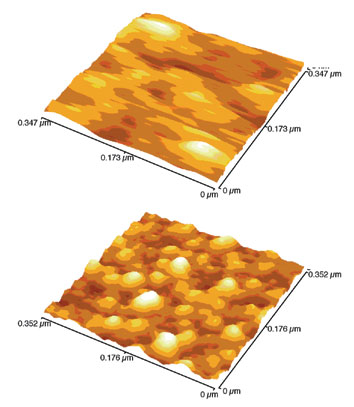| 2003 |

|
YEAR BOOK |
Cork Institute of Technology
|
A really soft touch
|

Firstly, the force applied to the sample by the AFM tip must be minimised by using non-contact mode AFM imaging. In this mode, the tip does not contact the sample surface but hovers above it, sensing the attractive force between the tip and the surface. This force is weak and the tip, mounted on a cantilever, has to be oscillated in order to be able to use sensitive AC signal recovery techniques. Secondly, it is important to oscillate the cantilever without introducing physical disturbances into the liquid around the sample. This is best achieved by adding a magnetic coating to the cantilever and then driving it with an external alternating magnetic field. The upper AFM image in the figure - of a monolayer of immobilised antibodies under water - was obtained with a new instrument developed at Cork Institute of Technology.
Despite using non-contact mode and magnetic drive of the cantilever, the image quality is inferior to that achieved in air. The primary reason for this is that the liquid environment significantly degrades the quality factor (sharpness of the resonance peak) of the oscillating cantilever. Fortunately, inserting an additional positive feedback loop (called active-Q control) into the detection system enables the high quality factor to be recovered. The lower AFM image in the figure shows the dramatic improvement obtained when active-Q control is implemented. Instruments with this calibre of performance will further extend the application of AFMs within the life sciences.
Contact: Dr Liam McDonnell, Centre for Surface & Interface Analysis, Department of Applied Physics & Instrumentation, Cork Institute of Technology; E-mail: [email protected]